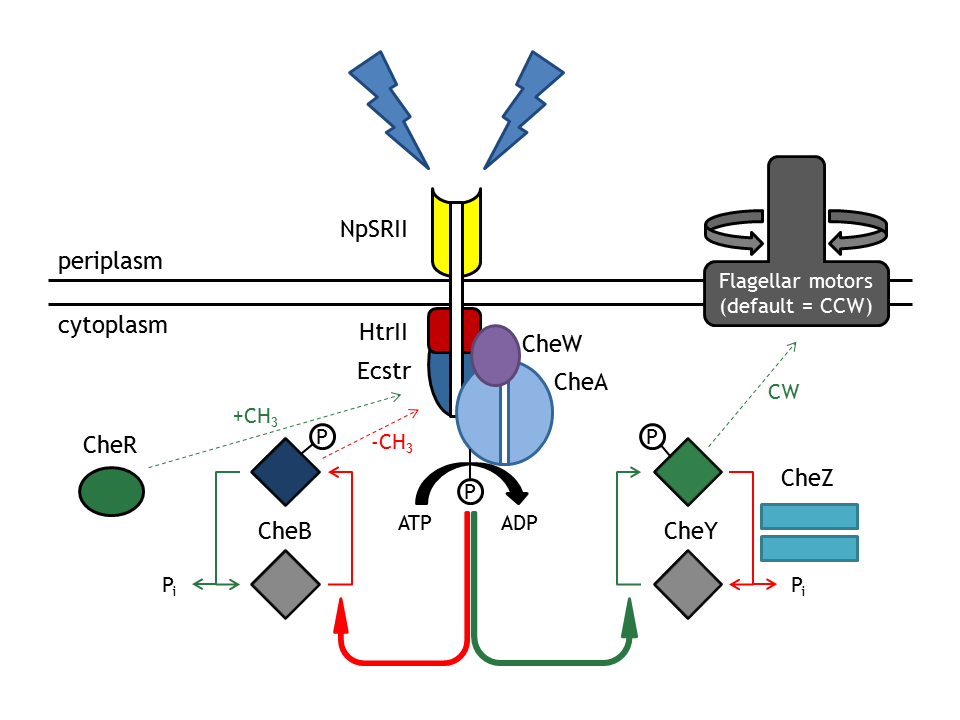Team:ETHZ Basel/Biology/Archeal Light Receptor
From 2010.igem.org
Archeal Light Receptor
Besides the light-sensitive Pif3/PhyB-system, another implementation strategy caught our attention: The generation of our E. lemming by the fusion of an archeal photoreceptor to a bacterial chemotactic transducer. This was successfully demonstrated by Jung et al. in 2001 [http://jb.asm.org/cgi/content/full/183/21/6365?maxtoshow=&hits=10&RESULTFORMAT=1&andorexacttitle=and&andorexacttitleabs=and&fulltext=An+archaeal+photosignal-transducing+module+mediates+phototaxis+in+%27%27Escherichia+&andorexactfulltext=and&searchid=1&FIRSTINDEX=0&sortspec=relevance&resourcetype=HWCIT:], who fused the Natronobacterium pharaonis NpSRII (Np seven-transmembrane retinylidene photoreceptor sensory rhodopsins II) and their cognate transducer HtrII to the cytoplasmic domain of the chemotaxis transducer EcTsr of Escherichia coli.
Rhodopsins are photoreactive, membrane-embedded proteins, which are found not only in archaea, but in eubacteria and microbes as well. In Natronobacterium pharaonis, the NpSRII contains a domain of seven membrane-spanning helices, which carry out two distinct functions: Firstly, they serve as photo-inducible ion-pumps and secondly, as actors in the chemotaxis signaling network [1].
Construct
We purchased the codon optimized version of the archeal photoreceptor NpSRII EcTsr-fusion from Geneart and cloned the sequence as biobrick into the standardized vector pSB1C3 ([http://partsregistry.org/Part:BBa_K422001 BBa_K422001]).
As membrane proteins are difficult to express at the appropriate concentrations, we decided to subclone the receptor into the IPTG-inducible plasmid pACT3 allowing us to adapt the expression level. The archeal receptor fusion was cloned into pACT3 via BamHI and HindIII. In addition to the BamHI site, the forward primer encodes for a ribosome binding site to ensure the optimal spacing to the start codon.
Forward (5'-3'): GTGGATCCAAGGAGATATACATATGGTTGGTCTGACCACCCTG
Reverse (5'-3'): GCAAGCTTTTAACCGCTATAAATTG
Chemotactic analysis
To observe chemotactic behaviour, cells were grown at 30 °C in Lysogeny Broth to on OD of 1.0. All-trans retinal has to be added to the media for NpSRII to change it's conformation into an active light absorbing pigment. Different levels of IPTG can influence the protein expression level.
Phototactic stimuli were delivered through a light pulse at 500 nm and cells tracked. You can find out more about microscopy and information processing here.
And don't forget, check out our results, the actual E. lemming.
Receptor analysis
Add: SDS Gel of expressed protein, membrane insertion?
References
[1] [http://jb.asm.org/cgi/content/full/183/21/6365?maxtoshow=&hits=10&RESULTFORMAT=1&andorexacttitle=and&andorexacttitleabs=and&fulltext=An+archaeal+photosignal-transducing+module+mediates+phototaxis+in+%27%27Escherichia+&andorexactfulltext=and&searchid=1&FIRSTINDEX=0&sortspec=relevance&resourcetype=HWCIT: Jung, Spudich, Trivedi and Spudich: An archaeal photosignal-transducing module mediates phototaxis in Escherichia coli. Journal of bacteriology. 2001; 21].
[2] [http://www.sciencemag.org/cgi/content/full/sci;293/5534/1499?maxtoshow=&hits=10&RESULTFORMAT=&andorexacttitle=or&andorexacttitleabs=or&fulltext=Crystal+Structure+of+Sensory+Rhodopsin+II+at+2.4+Angstroms&andorexactfulltext=or&searchid=1&FIRSTINDEX=0&sortspec=relevance&fdate=7/1/1880&tdate=10/31/2010&resourcetype=HWCIT,HWELTR: Hartmut Luecke, Brigitte Schobert, Janos K. Lanyi, Elena N. Spudich and John L. Spudich. Crystal Structure of Sensory Rhodopsin II at 2.4 Angstroms: Insights into Color Tuning and Transducer Interaction. Science Express. 2001; 293]
[3] [http://onlinelibrary.wiley.com/doi/10.1562/2006-07-05-RA-960/full: Enrica Bordignon, Johann P. Klare, Julia Holterhues, Swetlana Martell, Aliaksei Krasnaberski, Martin Engelhard and Heinz-Jürgen Steinhoff. Analysis of Light-Induced Conformational Changes of Natronomonas pharaonis Sensory Rhodopsin II by Time Resolved Electron Paramagnetic Resonance Spectroscopy. Photochemistry and Photobiology. 2007; 83 (2)]
[4] [http://www.ncbi.nlm.nih.gov/pmc/articles/PMC1302696/: Michael Hein, Ansgar A. Wegener, Martin Engelhard, and Friedrich Siebert. Time-Resolved FTIR Studies of Sensory Rhodopsin II (NpSRII) from Natronobacterium pharaonis: Implications for Proton Transport and Receptor Activation. Biophys J. 2003; 84]
[5] [http://www.cell.com/biophysj/abstract/S0006-3495(98)77588-5: Igor Chizhov, Georg Schmies, Ralf Seidel, Jens R. Sydor, Beate Lüttenberg and Martin Engelhard. The Photophobic Receptor from Natronobacterium pharaonis: Temperature and pH Dependencies of the Photocycle of Sensory Rhodopsin II. Biophysical Journal. 1898; 75(2)]
[6] [http://onlinelibrary.wiley.com/doi/10.1111/j.1751-1097.2009.00687.x/full: Gang Dai, Yoshikazu Ohno, Yoichi Ikeda, Jun Tamogami, Takashi Kikukawa, Naoki Kamo and Tatsuo Iwasa. Photoreaction Cycle of Phoborhodopsin (Sensory Rhodopsin II) from Halobacterium salinarum Expressed in Escherichia coli. Photochemistry and Photobiology.2010; 86(3)]
[7] [http://onlinelibrary.wiley.com/doi/10.1111/j.1751-1097.2008.00470.x/full: Young-Jun Kim, Igor Chizhov and Martin Engelhard. Functional Expression of the Signaling Complex Sensory Rhodopsin II/Transducer II from Halobacterium salinarum in Escherichia coli. Photochemistry and Photobiology. 2009; 85 (2)]
[8] [http://onlinelibrary.wiley.com/doi/10.1562/2006-03-20-IR-853/full: Kwang-Hwan Jung. The Distinct Signaling Mechanisms of Microbial Sensory Rhodopsins in Archaea, Eubacteria and Eukarya. Photochemistry and Photobiology. 2007; 83 (1)]
[9] [http://onlinelibrary.wiley.com/doi/10.1111/j.1432-1033.1992.tb16935.x/full: Birgit Scharf, Bernd Pevec, Benno Hess and Martin Engelhard. Biochemical and photochemical properties of the photophobic receptors from Halobacterium halobium and Natronobacterium pharaonis. European Journal of Biochemistry. 1992; 206 (2)]
[10] [http://onlinelibrary.wiley.com/doi/10.1046/j.1365-2958.2003.03395.x/full: Kwang-Hwan Jung, Vishwa D. Trivedi and John L. Spudich. Demonstration of a sensory rhodopsin in eubacteria. Molecular Microbiology. 2003; 47 (6)]
[11] [http://onlinelibrary.wiley.com/doi/10.1002/9783527629237.ch10/summary: Prof. Dr. Reinhard Krämer, Prof. Dr. Kirsten Jung, Sonja Brandt, and Nicole Frankenberg-Dinkel. Chapter 10: Photoreception and Signal Transduction. Bacterial Signaling. 2010.]
 "
"





